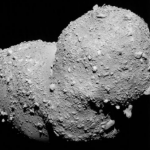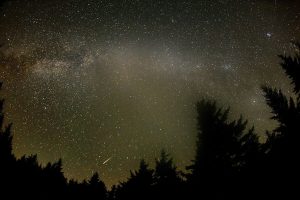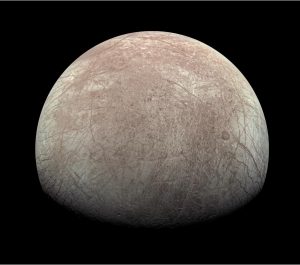
Global Space News: NASA’s Parker Solar Probe conducts “in-situ” observations of the solar atmosphere (corona)
The solar atmosphere known as the “corona” is an intensely hot region that is ionised to form a plasma of charged particles. Despite the Sun’s strong gravitational pull, the corona cannot be confined close to the Sun, and the plasma streams outwards in the form of the solar wind. The solar wind fills the space within the Solar System, until it is eventually blocked by interstellar gas. This region that is under the influence of the solar wind and dominated by the electromagnetic field and dynamics of that plasma gas is referred to as the “heliosphere”.
NASA has recently announced that “Humanity has touched the Sun”. But what does this mean?
The solar wind is accelerated by processes in the corona, causing the speed to increase with altitude from the surface of Sun. Below a certain altitude, the gas velocity is so low that its motion is controlled by the force from the Sun’s magnetic field. But when the gas velocity exceeds a threshold known as the Alfvén velocity, this influence is reversed and the gas flow pulls on the force lines of the magnetic field. This boundary where the roles of the plasma gas flow and magnetic field reverse is called the Alfvén critical surface.
The NASA Parker Solar Probe has been performing repeated close approaches to the Sun, crossed the Alfvén critical surface to make an “in-situ” observations of the plasma and electromagnetic fields in the region dominated by the magnetic field. The results suggest that the Sun’s corona is a quiet world, quite unlike the one we are familiar with in the solar wind.
The Parker Solar Probe has only reached the edge of the solar corona. But in order to understand the process that accelerates the solar wind within the corona, we need to know the state of the plasma before the acceleration begins in the region that extends just above the solar surface.
NASA’s Parker Solar Probe has been making a close approach to the Sun about every 3 months. JAXA’s Hinode satellite has been conducting coordinated observations on the occasion of approach. The purpose of the Parker Solar Probe is to understand the behaviour of the solar wind by “in-situ” observations of the plasma particles and magnetic fields that make up the solar wind.
Hinode observations are thought to be useful in identifying where the solar wind observed by the Parker Solar Probe is originating from on the surface of the Sun. There is, however, a large uncertainty in tracking the solar magnetic field from the surface to the point of the Parker Solar Probe, and the solar source has not been identified. Over the next few years, the Parker Solar Probe will move closer to the Sun. After the mid-2020s, when the closest approach will be realised, the next solar observation satellite Solar-C (EUVST), which is currently under development, will fly. By observing the velocities of plasmas of various ion species at unprecedented resolution, I wish to identify the connection from the surface of the Sun to the corona and the heliosphere
Shimizu Toshifumi, SOLAR-B (Hinode) Project Manager
The solar wind pulls the Sun’s magnetic field into the heliosphere. Activity on the surface of the Sun therefore creates fluctuations in the solar wind and the magnetic field carried by the solar wind. This travels outwards into the heliosphere, affecting the region that include the space around the Earth.
In fact, the 2020s have seen observations of the inner heliosphere within the Earth’s orbit become more extensive than ever before with not only NASA’s Parker Solar Probe, but also with ESA’s Solar Orbiter and others. Together with these international missions, Japan will be contributing to the inner heliospheric observational network with the Mercury orbiter “Mio” that will measure the solar wind at Mercury’s orbit, and the space environment around Mercury, the solar observatory “Solar-C (EUVST)” which is set to tackle the mystery of the solar-wind acceleration at the Sun, and by the geospace explorer “Arase” which is observing dynamic variations of the space environment around the Earth driven by the solar wind.
Making use of ground-based solar wind observations and numerical simulations in addition to the observations from these explorers, JAXA/ISAS and Institute for Space-Earth Environmental Research (ISEE) at Nagoya University will tightly collaborate to lead research on the heliosphere, considering the space environment from the solar surface to the space around the Earth and planets as a unified system.
We are so excited about this exciting chance to reveal how the magnetic field fluctuations on the solar surface propagate into the heliosphere and affect the space environment around the Earth and planetary space through the integration of the inner heliospheric data as a whole
Shinohara Iku, Associate Professor, Department of Solar System Sciences
On November 4, 2021 the sounding rocket SS-520-3 was launched from the launch site in the Arctic Svalbard Islands into the cusp region; a channel that connects the Earth’s atmosphere with outer space.
The Sun is important for our planet Earth, but its influence can have a variety of consequences. The activity of the Sun is expected to increase over the next few years. Last November, we successfully launched the sounding rocket SS-520-3 from Spitsbergen Island in the Arctic Ocean to investigate the phenomenon of the escape of the atmosphere from the Earth’s ionosphere into space; an event that is more marked during high solar activity. The scheduled observation was a great success, because two days before the launch of the rocket, an explosion occurred on the surface of the Sun, known as a solar flare. The solar flare reached the Earth and caused the first geomagnetic storm in quite a long time. Thanks, Sun!
Saito Yoshifumi, SS-520-3 Sounding Rocket Experiment Principal Investigator
Article written by Fujimoto Masaki. Translation by Elizabeth Tasker.
“Global space news” is a chance for us to highlight important developments across the world and share our excitement of these achievements.
Further information:
The NASA Parker Solar Probe (NASA/APL site)
Solar Observing Satellite Hinode (NAOJ site)
Next-generation Solar-observing Satellite Solar-C (EUVST)
Gallery from the launch of the SS-520-3 sounding rocket in Svalbard




 Previous Post
Previous Post Next Post
Next Post






